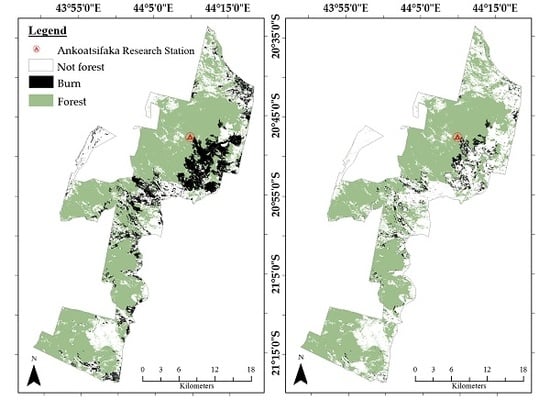Burned Area Mapping of an Escaped Fire into Tropical Dry Forest in Western Madagascar Using Multi-Season Landsat OLI Data
Abstract
:1. Introduction
2. Materials and Methods
2.1. Study Area
2.2. Image Analysis
2.3. Burn Mapping
2.4. Multi-Temporal Kauth-Thomas Transform
2.5. Burn Classification
2.6. Forest Classification
3. Results and Discussion
3.1. Burn Classification Map
3.2. Forest Classification Map
4. Conclusions
Acknowledgments
Conflicts of Interest
References
- Hansen, M.C.; Stehman, S.V.; Potapov, P.V. Quantification of global gross forest cover loss. Proc. Natl. Acad. Sci. USA 2010, 107, 8650–8655. [Google Scholar] [CrossRef] [PubMed]
- Murphy, P.G.; Lugo, A.E. Ecology of tropical dry forest. Annu. Rev. Ecol. Syst. 1986, 17, 67–88. [Google Scholar] [CrossRef]
- Gerhardt, K.; Hytteborn, H. Natural dynamics and regeneration methods in tropical dry forests—An introduction. J. Veg. Sci. 1992, 3, 361–364. [Google Scholar] [CrossRef]
- Miles, L.; Newton, A.C.; DeFries, R.S.; Ravilious, C.; May, I.; Blyth, S.; Kapos, V.; Gordon, J.E. A global overview of the conservation status of tropical dry forests. J. Biogeogr. 2006, 33, 491–505. [Google Scholar] [CrossRef]
- Hoekstra, J.M.; Boucher, T.M.; Ricketts, T.H.; Roberts, C. Confronting a biome crisis: Global disparities of habitat loss and protection. Ecol. Lett. 2005, 8, 23–29. [Google Scholar] [CrossRef]
- Lerdau, M.; Whitbeck, J.; Holbrook, N.M. Tropical deciduous forest: Death of a biome. Trends Ecol. Evol. 1991, 6, 201–202. [Google Scholar] [CrossRef]
- Barreda-Bautista, B.; López-Caloca, A.A.; Couturier, S.; Silván-Cárdenas, J.L. Tropical Dry Forests in the Global Picture: The Challenge of Remote Sensing-Based Change Detection in Tropical Dry Environments. In Planet Earth 2011—Global Warming Challenges and Opportunities for Policy and Practice; Carayannis, E., Ed.; InTech: Rijeka, Croatia, 2011; pp. 231–256. [Google Scholar]
- Hesketh, M.; Sánchez-Azofeifa, A. A Review of Remote Sensing of Tropical Dry Forests. In Tropical Dry Forests in the Americas: Ecology, Conservation, and Management; Quesada, M., Ed.; CRC Press: Boca Raton, FL, USA, 2013; pp. 83–100. [Google Scholar]
- Sunderland, T.; Apgaua, D.; Baldauf, C.; Blackie, R.; Colfer, C.; Cunningham, A.B.; Dexter, K.; Djoudi, H.; Gautier, D.; Gumbo, D.; et al. Global dry forests: A prologue. Int. For. Rev. 2015, 17, 1–9. [Google Scholar] [CrossRef]
- Sanchez-Azofeifa, G.A.; Castro, K.L.; Rivard, B.; Kalascka, M.R.; Harriss, R.C. Remote sensing research priorities in tropical dry forest environments. Biotropica 2003, 35, 134–142. [Google Scholar] [CrossRef]
- Martinuzzi, S.; Gould, W.A.; Vierling, L.A.; Hudak, A.T.; Nelson, R.F.; Evans, J.S. Quantifying tropical dry forest type and succession: Substantial improvement with LiDAR. Biotropica 2013, 45, 135–146. [Google Scholar] [CrossRef]
- Cochrane, M.A. In the line of fire: Understanding the impacts of tropical forest fires. Environment 2001, 43, 28–38. [Google Scholar] [CrossRef]
- Cochrane, M.A. Fire science for rainforests. Nature 2003, 421, 913–919. [Google Scholar] [CrossRef] [PubMed]
- Cochrane, M.A. Positive feedbacks in the fire dynamic of closed canopy tropical forests. Science 1999, 284, 1832–1835. [Google Scholar] [CrossRef] [PubMed]
- Alencar, A.; Asner, G.P.; Knapp, D.; Zarin, D. Temporal variability of forest fires in eastern Amazonia. Ecol. Appl. 2014, 21, 2397–2412. [Google Scholar] [CrossRef]
- DeFries, R.; Hansen, A.; Newton, A.C.; Hansen, M.C. Increasing isolation of protected areas in tropical forests over the past twenty years. Ecol. Appl. 2005, 15, 19–26. [Google Scholar] [CrossRef]
- Réau, B. Burning for zebu: The complexity of deforestation issues in western Madagascar. Nor. J. Geogr. 2002, 56, 219–229. [Google Scholar] [CrossRef]
- Gorenflo, L.J.; Corson, C.; Chomitz, K.M.; Harper, G. Exploring the association between people and deforestation in Madagascar. In Human Population: It’s Influences on Biological Diversity; Cincotta, R.P., Gorenflo, L.J., Eds.; Ecological Studies; Springer: Berlin/Heidelberg, Germany, 2011; Volume 214, pp. 197–221. [Google Scholar]
- Smith, A.P. Deforestation, fragmentation and reserve design in western Madagascar. In Tropical Forest Remnants, Ecology, Management and Conservation of Fragmented Communities; Laurence, W.F., Bierregaard, R.O.J., Eds.; The University of Chicago Press: Chicago, IL, USA, 1997. [Google Scholar]
- Scales, I.R. Farming at the forest frontier: Land use and landscape change in western Madagascar, 1896–2005. Environ. Hist. Camb. 2011, 17, 499–524. [Google Scholar] [CrossRef]
- Zinner, D.; Wygoda, C.; Razafimanantsoa, L.; Rasoloarison, R.; Andrianandrasana, H.T.; Ganzhorn, J.U.; Torkler, F. Analysis of deforestation patterns in the central Menabe, Madagascar, between 1973 and 2010. Reg. Environ. Chang. 2014, 14, 157–166. [Google Scholar] [CrossRef]
- Scales, I.R. Lost in translation: Conflicting views of deforestation, land use and identity in western Madagascar. Geogr. J. 2012, 178, 67–79. [Google Scholar] [CrossRef] [PubMed]
- Scales, I.R. The drivers of deforestation and the complexity of land use in Madagascar. In Conservation and Environmental Management in Madagascar; Scales, I.R., Ed.; Routledge: London, UK, 2014; pp. 105–125. [Google Scholar]
- Genini, M. Deforestation. Primate Rep. 1996, 46, 49–55. [Google Scholar]
- Raharimalala, O.; Buttler, A.; Dirac Ramohavelo, C.; Razanaka, S.; Sorg, J.P.; Gobat, J.M. Soil-vegetation patterns in secondary slash and burn successions in Central Menabe, Madagascar. Agric. Ecosyst. Environ. 2010, 139, 150–158. [Google Scholar] [CrossRef]
- Ramohavelo, C.D. Stratégies Villageoises pour la Gestion des Paysages Forestiers du Menabe Central, Madagascar; École Polytechnique Fédérale de Lausanne: Lausanne, Switzerland, 2009. [Google Scholar]
- Leimberger, K.G.; Lewis, R.J. Patterns of male dispersal in Verreaux’s sifaka (Propithecus verreauxi) at Kirindy Mitea National Park. Am. J. Primatol. 2017. [Google Scholar] [CrossRef] [PubMed]
- Rasatatsihoarana, T.F. Reconnaissances Écologiques des Aires Forestières Dans le Menabe sud en vue D’une Délimitation de Nouvelles Aires Protégées; Trans-Mad’Développement: Antananarivo, Madagascar, 2007. [Google Scholar]
- Zinner, D.P.; Ostner, J.; Dill, A.; Razafimanantsoa, L.; Rasoloarison, R.M. Results of a reconnaissance expedition in the western dry forests between Morondava and Morombe. Lemur News 2001, 6, 16–18. [Google Scholar]
- Key, C.H.; Benson, N.C. Landscape assessment: Ground measure of severity, the Composite Burn Index; and remote sensing of severity, the Normalized Burn Ratio. In FIREMON: Fire Effects Monitoring and Inventory System. USDA Forest Service Gen. Tech. Rep. RMRS-GTR-164-CD; Lutes, D.C., Kean, R.E., Caratti, J.F., Key, C.H., Benson, N.C., Sutherland, S., Gangi, L.J., Eds.; U.S. Department of Agriculture, Forest Service, Rocky Mountain Research Station: Fort Collins, CO, USA, 2006; p. LA-1-55. [Google Scholar]
- Kontoes, C.C.; Poilvé, H.; Florsch, G.; Keramitsoglou, I.; Paralikidis, S. A comparative analysis of a fixed thresholding vs. a classification tree approach for operational burn scar detection and mapping. Int. J. Appl. Earth Obs. Geoinf. 2009, 11, 299–316. [Google Scholar] [CrossRef]
- Ressl, R.; Lopez, G.; Cruz, I.; Colditz, R.R.; Schmidt, M.; Ressl, S.; Jiménez, R. Operational active fire mapping and burnt area identification applicable to Mexican Nature Protection Areas using MODIS and NOAA-AVHRR direct readout data. Remote Sens. Environ. 2009, 113, 1113–1126. [Google Scholar] [CrossRef]
- Henry, M.C. Comparison of single- and multi-date Landsat data for mapping wildfire scars in Ocala National Forest, Florida. Photogramm. Eng. Remote Sens. 2008, 74, 881–891. [Google Scholar] [CrossRef]
- Escuin, S.; Navarro, R.; Fernández, P. Fire severity assessment by using NBR (Normalized Burn Ratio) and NDVI (Normalized Difference Vegetation Index) derived from LANDSAT TM/ETM images. Int. J. Remote Sens. 2008, 29, 1053–1073. [Google Scholar] [CrossRef]
- Cocke, A.E.; Fulé, P.Z.; Crouse, J.E. Comparison of burn severity assessments using Differenced Normalized Burn Ratio and ground data. Int. J. Wildl. Fire 2005, 14, 189. [Google Scholar] [CrossRef]
- Rogan, J.; Yool, S.R. Mapping fire-induced vegetation depletion in the Peloncillo Mountains, Arizona and New Mexico. Int. J. Remote Sens. 2001, 22, 3101–3121. [Google Scholar] [CrossRef]
- Holden, Z.A.; Morgan, P.; Hudak, A.T. Burn severity of areas reburned by wildfires on the Gila National Forest, New Mexico, USA. Fire Ecol. 2010, 6, 77–85. [Google Scholar] [CrossRef]
- Kolden, C.A.; Lutz, J.A.; Key, C.H.; Kane, J.T.; van Wagtendonk, J.W. Mapped versus actual burned area within wildfire perimeters: Characterizing the unburned. For. Ecol. Manag. 2012, 286, 38–47. [Google Scholar] [CrossRef]
- Patterson, M.W.; Yool, S.R. Mapping fire-induced vegetation mortality using Landsat Thematic Mapper data: A comparison of linear transformation techniques. Remote Sens. Environ. 1998, 65, 132–142. [Google Scholar] [CrossRef]
- Barrett, K.; McGuire, A.D.; Hoy, E.E.; Kasischke, E.S. Potential shifts in dominant forest cover in interior Alaska driven by variations in fire severity. Ecol. Appl. 2011, 21, 2380–2396. [Google Scholar] [CrossRef] [PubMed]
- Healey, S.; Cohen, W.; Zhiqiang, Y.; Krankina, O. Comparison of Tasseled Cap-based Landsat data structures for use in forest disturbance detection. Remote Sens. Environ. 2005, 97, 301–310. [Google Scholar] [CrossRef]
- Masek, J.G.; Huang, C.; Wolfe, R.; Cohen, W.; Hall, F.; Kutler, J.; Nelson, P. North American forest disturbance mapped from a decadal Landsat record. Remote Sens. Environ. 2008, 112, 2914–2926. [Google Scholar] [CrossRef]
- Koechlin, J.; Guillaumet, J.-L.; Morat, P. Flore et Végétation de Madagascar; Gantner Verlag: Vaduz, Liechtenstein, 1997. [Google Scholar]
- Bond, W.J.; Silander, J.A., Jr.; Ranaivonasy, J.; Ratsirarson, J. The antiquity of Madagascar’s grasslands and the rise of C4 grassy biomes. J. Biogeogr. 2008, 35, 1743–1758. [Google Scholar] [CrossRef]
- Parcs Nationaux Madagascar. Plan de Gestion de la Conservation Parc National Kirindy Mite; Ministère de l’Environnement et des Eaux et Forêts, Direction Inter Régional de l'ANGAP à Toliara: Toliara, Madagascar, 2002.
- Lewis, R.J.; Bannar-Martin, K.H. The impact of Cyclone Fanele on a tropical dry forest in Madagascar. Biotropica 2012, 44, 135–140. [Google Scholar] [CrossRef]
- Lewis, R. Ankoatsifaka Research Station. Available online: https://labs.la.utexas.edu/ankoatsifaka/field-station/ (accessed on 10 October 2017).
- Roy, D.P.; Wulder, M.A.; Loveland, T.R.; Woodcock, C.E.; Allen, R.G.; Anderson, M.C.; Helder, D.; Irons, J.R.; Johnson, D.M.; Kennedy, R.; et al. Landsat-8: Science and product vision for terrestrial global change research. Remote Sens. Environ. 2014, 145, 154–172. [Google Scholar] [CrossRef]
- Roy, D.P.; Kovalskyy, V.; Zhang, H.K.; Vermote, E.F.; Yan, L.; Kumar, S.S.; Egorov, A. Characterization of Landsat-7 to Landsat-8 reflective wavelength and normalized difference vegetation index continuity. Remote Sens. Environ. 2016, 185, 57–70. [Google Scholar] [CrossRef]
- Brown, J.K. Introduction and fire regimes. In Wildland Fire in Ecosystems: Effects of Fire on Flora; Brown, J.K., Kapler, J., Eds.; General Technical Report RMRS-GTR-164-CD; USDA Forest Service, Rocky Mountain Research Station: Fort Collins, CO, USA, 2000; pp. 1–8. [Google Scholar]
- Collins, J.B.; Woodcock, C.E. An assessment of several linear change detection techniques for mapping forest mortality using multitemporal landsat TM data. Remote Sens. Environ. 1996, 56, 66–77. [Google Scholar] [CrossRef]
- Qi, J.; Chehbouni, A.; Huete, A.R.; Herr, Y.H.; Sorooshian, S. A Modified Soil Adjusted Vegetation Index. Remote Sens. 1994, 48, 119–126. [Google Scholar] [CrossRef]
- García-Haro, F.J.; Gilabert, M.A.; Meliá, J. Monitoring fire-affected areas using Thematic Mapper data. Int. J. Remote Sens. 2001, 22, 533–549. [Google Scholar] [CrossRef]
- Richards, J.A. Thematic mapping from multitemporal image data using the principal components transformation. Remote Sens. Environ. 1984, 16, 35–46. [Google Scholar] [CrossRef]
- Fung, T. An assessment of TM imagery for land-cover change detection. IEEE Trans. Geosci. Remote Sens. 1990, 28, 681–684. [Google Scholar] [CrossRef]
- Fisher, R.; Vigilante, T.; Yates, C.; Russell-Smith, J. Patterns of landscape fire and predicted vegetation response in the North Kimberley region of Western Australia. Int. J. Wildl. Fire 2003, 12, 369. [Google Scholar] [CrossRef]
- Potere, D.; Woodcock, C.E.; Schneider, A.; Ozdogan, M.; Baccini, A. Patterns in forest clearing along the Appalachian Trail Corridor. Photogramm. Eng. Remote Sens. 2007, 73, 783–791. [Google Scholar] [CrossRef]
- Kauth, R.J.; Thomas, G.S. The Tasselled Cap—A Graphic Description of the Spectral-Temporal Development of Agricultural Crops as Seen by Landsat; Purdue University: West Lafayette, IN, USA, 1976. [Google Scholar]
- Crist, E.P.; Cicone, R.C. A physically-based transformation of Thematic Mapper data—The TM Tasseled Cap. IEEE Trans. Geosci. Remote Sens. 1984, GE-22, 256–263. [Google Scholar] [CrossRef]
- Baig, M.H.A.; Zhang, L.; Shuai, T.; Tong, Q. Derivation of a tasselled cap transformation based on Landsat 8 at-satellite reflectance. Remote Sens. Lett. 2014, 5, 423–431. [Google Scholar] [CrossRef]
- Lutes, D.C.; Keane, R.E.; Caratti, J.F.; Key, C.H.; Benshon, N.C.; Sutherland, S.; Gangi, L.J. FIREMON: Fire Effects Monitoring and Inventory System; General Technical Report RMRS-GTR-164-CD; USDA Forest Service, Rocky Mountain Research Station: Fort Collins, CO, USA, 2006.
- Fang, L.; Yang, J. Atmospheric effects on the performance and threshold extrapolation of multi-temporal Landsat derived dNBR for burn severity assessment. Int. J. Appl. Earth Obs. Geoinf. 2014, 33, 10–20. [Google Scholar] [CrossRef]
- Miller, J.D.; Thode, A.E. Quantifying burn severity in a heterogeneous landscape with a relative version of the delta Normalized Burn Ratio (dNBR). Remote Sens. Environ. 2007, 109, 66–80. [Google Scholar] [CrossRef]
- Zhang, G.; Xiao, X.; Dong, J.; Kou, W.; Jin, C.; Qin, Y.; Zhou, Y.; Wang, J.; Menarguez, M.A.; Biradar, C. Mapping paddy rice planting areas through time series analysis of MODIS land surface temperature and vegetation index data. ISPRS J. Photogramm. Remote Sens. 2015, 106, 157–171. [Google Scholar] [CrossRef] [PubMed]
- Müller, D.; Suess, S.; Hoffmann, A.A.; Buchholz, G. The Value of satellite-based active fire data for monitoring, reporting and verification of REDD+ in the Lao PDR. Hum. Ecol. 2013, 41, 7–20. [Google Scholar] [CrossRef]
- Gong, P.; Wang, J.; Yu, L.; Zhao, Y.; Zhao, Y.; Liang, L.; Niu, Z.; Huang, X.; Fu, H.; Liu, S.; et al. Finer resolution observation and monitoring of global land cover: First mapping results with Landsat TM and ETM+ data. Int. J. Remote Sens. 2013, 34, 2607–2654. [Google Scholar] [CrossRef]
- Olofsson, P.; Foody, G.M.; Stehman, S.V.; Woodcock, C.E. Making better use of accuracy data in land change studies: Estimating accuracy and area and quantifying uncertainty using stratified estimation. Remote Sens. Environ. 2013, 129, 122–131. [Google Scholar] [CrossRef]
- Kalacska, M.; Sanchez-Azofeifa, G.A.; Rivard, B.; Caelli, T.; White, H.P.; Calvo-Alvarado, J.C. Ecological fingerprinting of ecosystem succession: Estimating secondary tropical dry forest structure and diversity using imaging spectroscopy. Remote Sens. Environ. 2007, 108, 82–96. [Google Scholar] [CrossRef]
- Arroyo-Mora, J.P.; Sanchez-Azofeifa, A.; Kalacska, M.E.R.; Rivard, B. Secondary forest detection in a neotropical dry forest landscape using Landsat 7. Biotropica 2005, 37, 497–507. [Google Scholar] [CrossRef]
- Bohlman, S.A.; Adams, J.B.; Smith, M.O.; Peterson, D.L. Seasonal foliage changes in the Eastern Amazon Basin detected from Landsat Thematic Mapper satellite images. Biotropica 1998, 30, 376–391. [Google Scholar] [CrossRef]
- Tottrup, C. Improving tropical forest mapping using multi-date Landsat TM data and pre-classification image smoothing. Int. J. Remote Sens. 2004, 25, 717–730. [Google Scholar] [CrossRef]
- Haboudane, D.; Miller, J.R.; Pattey, E.; Zarco-Tejada, P.J.; Strachan, I.B. Hyperspectral vegetation indices and novel algorithms for predicting green LAI of crop canopies: Modeling and validation in the context of precision agriculture. Remote Sens. Environ. 2004, 90, 337–352. [Google Scholar] [CrossRef]
- Wood, E.M.; Pidgeon, A.M.; Radeloff, V.C.; Keuler, N.S. Image texture as a remotely sensed measure of vegetation structure. Remote Sens. Environ. 2012, 121, 516–526. [Google Scholar] [CrossRef]
- Anys, H.; He, D.C. Evaluation of Textural and Multipolarization Radar Features for Crop Classification. IEEE Trans. Geosci. Remote Sens. 1995, 33, 1170–1181. [Google Scholar] [CrossRef]
- Irons, J.R.; Petersen, G.W. Texture transforms of remote sensing data. Remote Sens. Environ. 1981, 11, 359–370. [Google Scholar] [CrossRef]
- Congalton, R.G. A review of assessing the accuracy of classifications of remotely sensed data. Remote Sens. Environ. 1991, 37, 35–46. [Google Scholar] [CrossRef]
- Rosenfield, G.H.; Fitzpatrick-Lins, K. A coefficient of agreement as a measure of thematic classification accuracy. Photogramm. Eng. Remote Sens. 1986, 52, 223–227. [Google Scholar]
- Fitzgerald, R.W.; Lees, B.G. Assessing the classification accuracy of multisource remote sensing data. Remote Sens. Environ. 1994, 47, 362–368. [Google Scholar] [CrossRef]
- Congalton, R.G.; Green, K. Assessing the Accuracy of Remotely Sensed Data: Principles and Practices, 2nd ed.; CRC Press: Boca Raton, FL, USA, 2009. [Google Scholar]
- Pontius, R.G.; Millones, M. Death to Kappa: Birth of quantity disagreement and allocation disagreement for accuracy assessment. Int. J. Remote Sens. 2011, 32, 4407–4429. [Google Scholar] [CrossRef]
- Stein, A.; Aryal, J.; Gort, G. Use of the Bradley-Terry model to quantify association in remotely sensed images. IEEE Trans. Geosci. Remote Sens. 2005, 43, 852–856. [Google Scholar] [CrossRef]
- McCarley, T.R.; Kolden, C.A.; Vaillant, N.M.; Hudak, A.T.; Smith, A.M.S.; Wing, B.M.; Kellogg, B.S.; Kreitler, J. Multi-temporal LiDAR and Landsat quantification of fire-induced changes to forest structure. Remote Sens. Environ. 2017, 191, 419–432. [Google Scholar] [CrossRef]
- Everham, E.M., III; Brokaw, N.V.L. Forest damage and recovery from catastrophic wind. Bot. Rev. 2016, 62, 113–185. [Google Scholar] [CrossRef]
- Xi, W. Synergistic effects of tropical cyclones on forest ecosystems: A global synthesis. J. For. Res. 2015, 26, 1–21. [Google Scholar] [CrossRef]
- Myers, R.L. Fire in tropical and subtropical ecosystems. In Wildland Fire and Ecosystems: Effects of Fire on Flora; Brown, J.K., Kapler, J., Eds.; General Technical Report RMRS-GTR-164-CD; USDA Forest Service, Rocky Mountain Research Station: Fort Collins, CO, USA, 2000; Volume 2, pp. 161–174. [Google Scholar]
- Portillo-Quintero, C.A.; Sánchez-Azofeifa, G.A. Extent and conservation of tropical dry forests in the Americas. Biol. Conserv. 2010, 143, 144–155. [Google Scholar] [CrossRef]
- Helmer, E.H.; Ruzycki, T.S.; Benner, J.; Voggesser, S.M.; Scobie, B.P.; Park, C.; Fanning, D.W.; Ramnarine, S. Detailed maps of tropical forest types are within reach: Forest tree communities for Trinidad and Tobago mapped with multiseason Landsat and multiseason fine-resolution imagery. For. Ecol. Manag. 2012, 279, 147–166. [Google Scholar] [CrossRef]
- Feeley, K.J.; Gillespie, T.W.; Terborgh, J.W. The utility of spectral indices from Landsat ETM+ for measuring structure and composition of tropical dry forests. Biotropica 2005, 37, 508–519. [Google Scholar] [CrossRef]
- Nagendra, H.; Rocchini, D.; Ghate, R.; Sharma, B.; Pareeth, S. Assessing plant diversity in a dry tropical forest: Comparing the utility of Landsat and Ikonos satellite images. Remote Sens. 2010, 2, 478–496. [Google Scholar] [CrossRef]
- Gu, Y.; Wylie, B.K.; Howard, D.M.; Phuyal, K.P.; Ji, L. NDVI saturation adjustment: A new approach for improving cropland performance estimates in the Greater Platte River Basin, USA. Ecol. Indic. 2013, 30, 1–6. [Google Scholar] [CrossRef]
- Norman, S.P.; Koch, F.H.; Hargrove, W.W. Detecting and monitoring large-scale drought effects on forests: Toward an integrated approach. In GTR-WO-93b Effects of Drought on Forests and Rangelands in the United States; US Department of Agriculture, Forest Service, Southern Research Station (SRS), Eastern Forest Environmental Threat Assessment Center (EFETAC): Asheville, NC, USA, 2016; pp. 196–229. [Google Scholar]
- Tanser, F.; Palmer, A.R. Vegetation mapping of the Great Fish River basin, South Africa: Integrating spatial and multi-spectral remote sensing techniques. Appl. Veg. Sci. 2000, 3, 197–204. [Google Scholar] [CrossRef]
- Lu, D. Aboveground biomass estimation using Landsat TM data in the Brazilian Amazon. Braz. Amaz. Int. J. Remote Sens. 2005, 26, 2509–2525. [Google Scholar] [CrossRef]
- Kushwaha, S.P.S.; Kuntz, S.; Oesten, G. Applications of image texture in forest classification. Int. J. Remote Sens. 1994, 15, 2273–2284. [Google Scholar] [CrossRef]
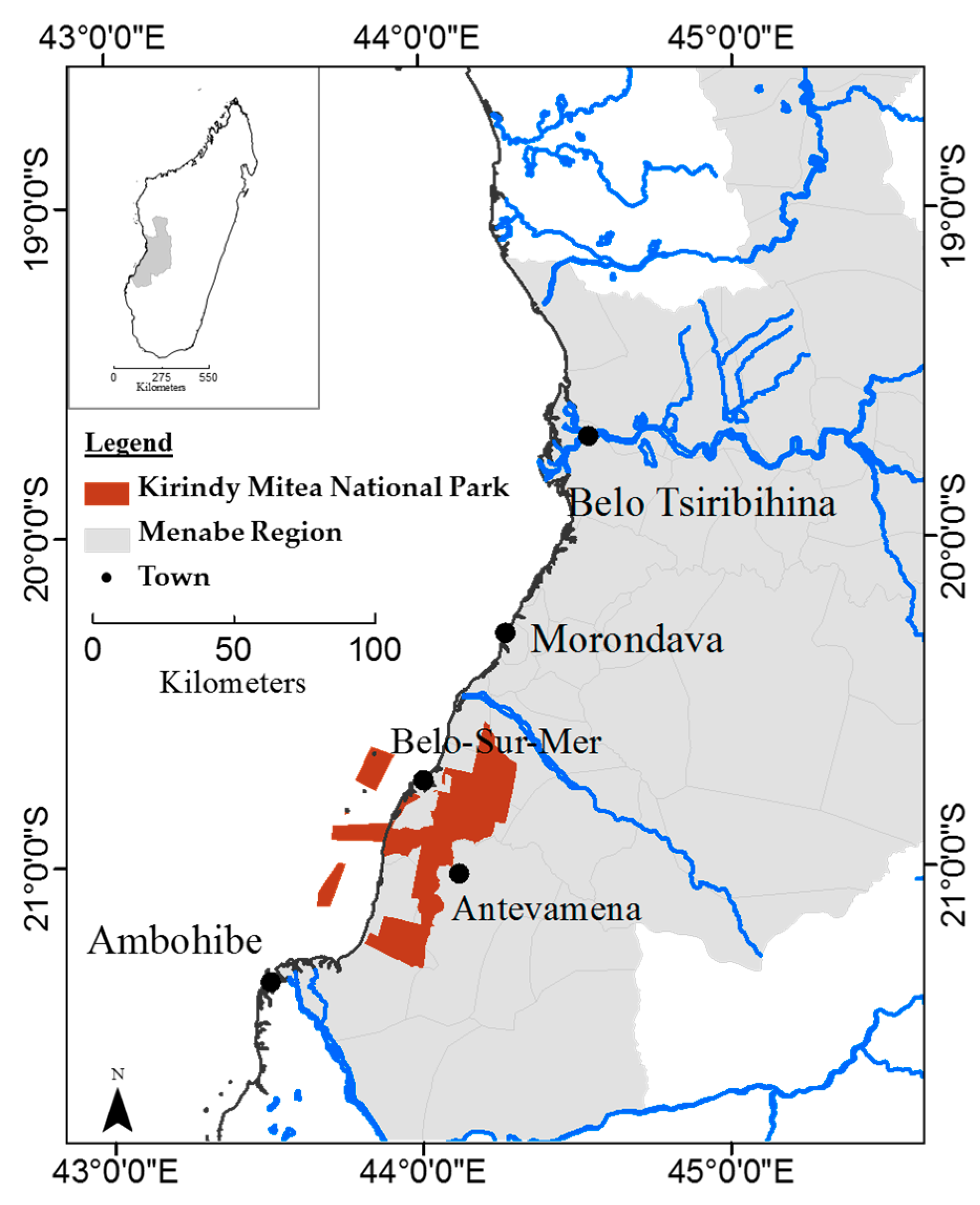
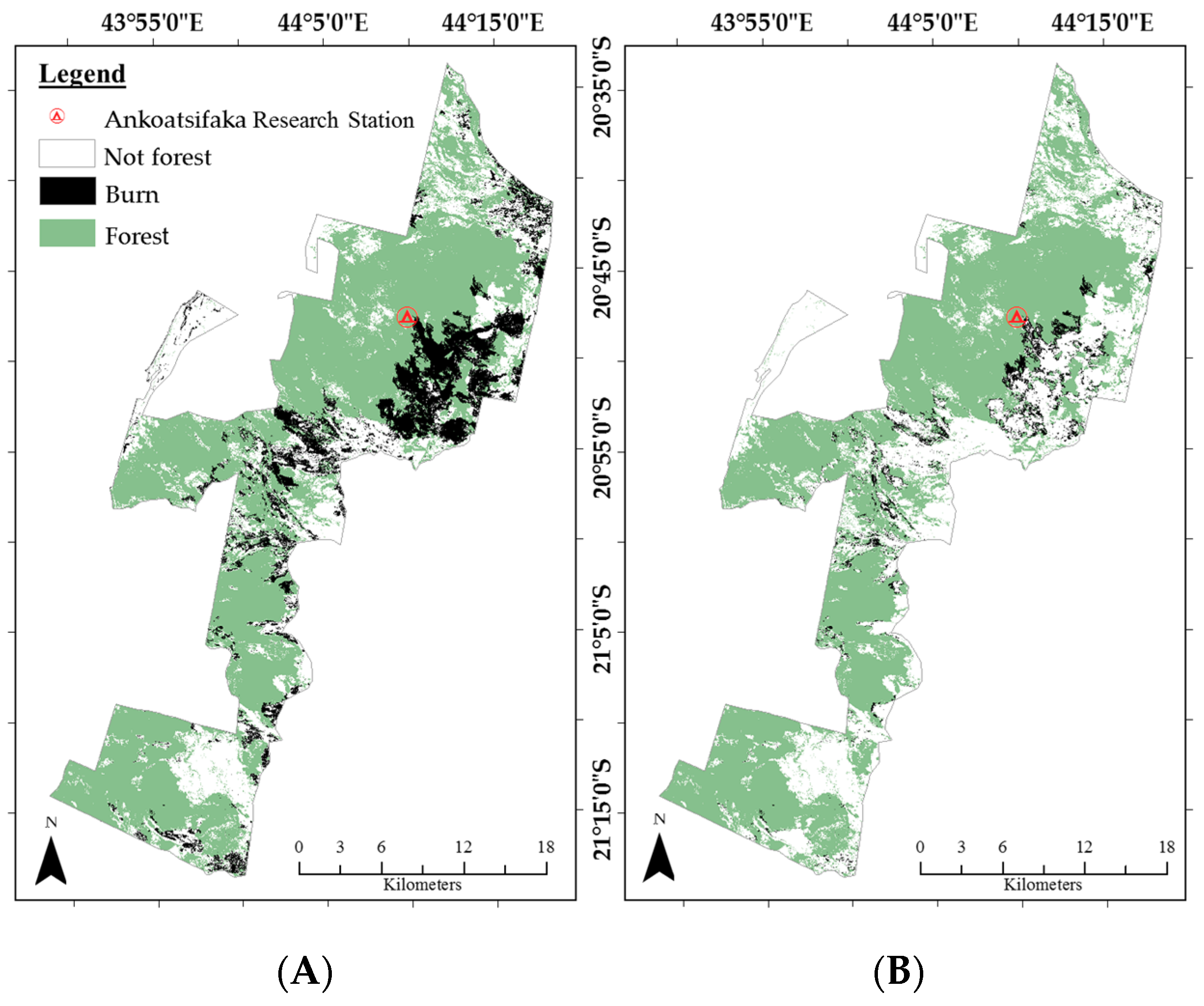
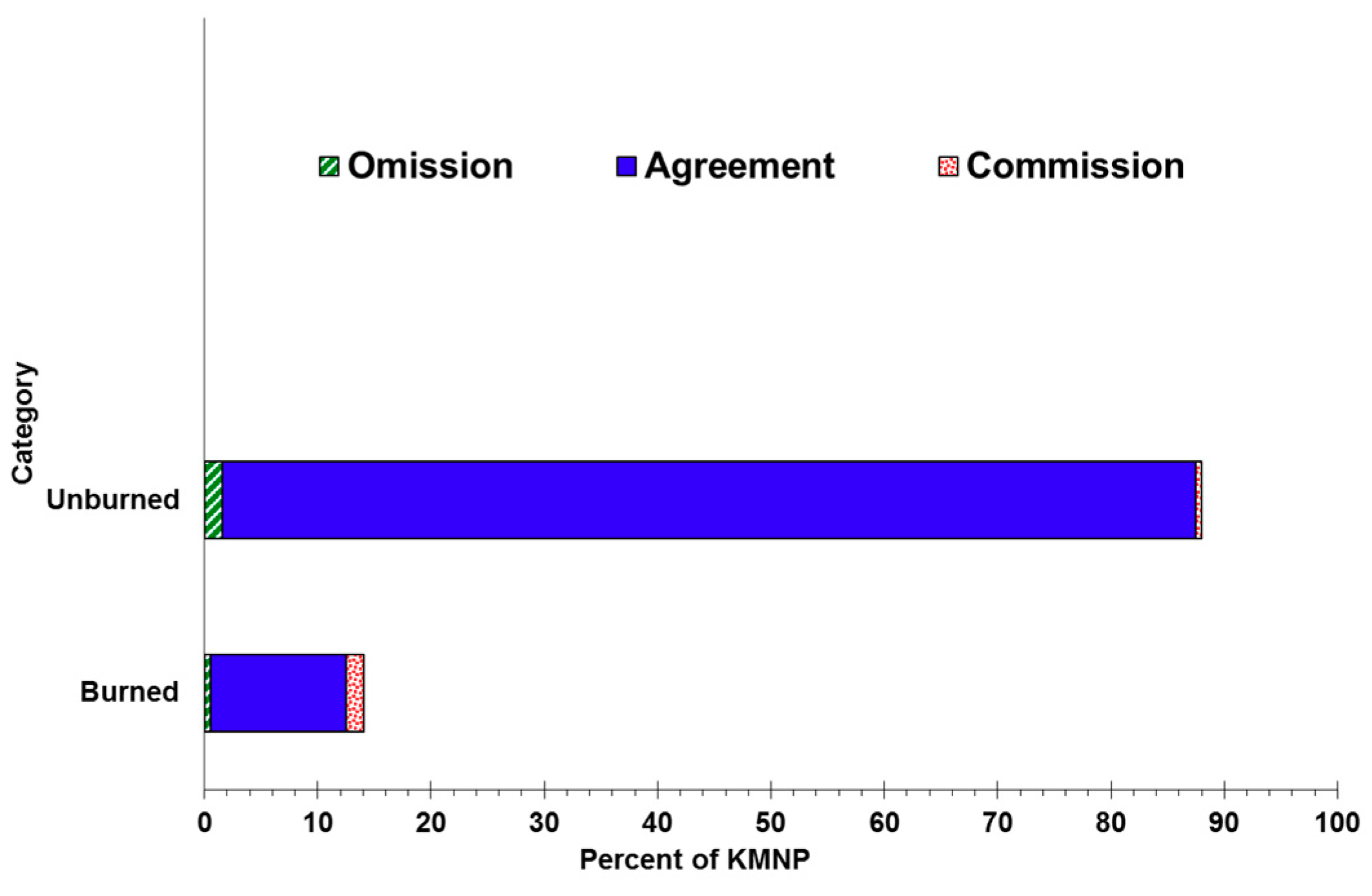
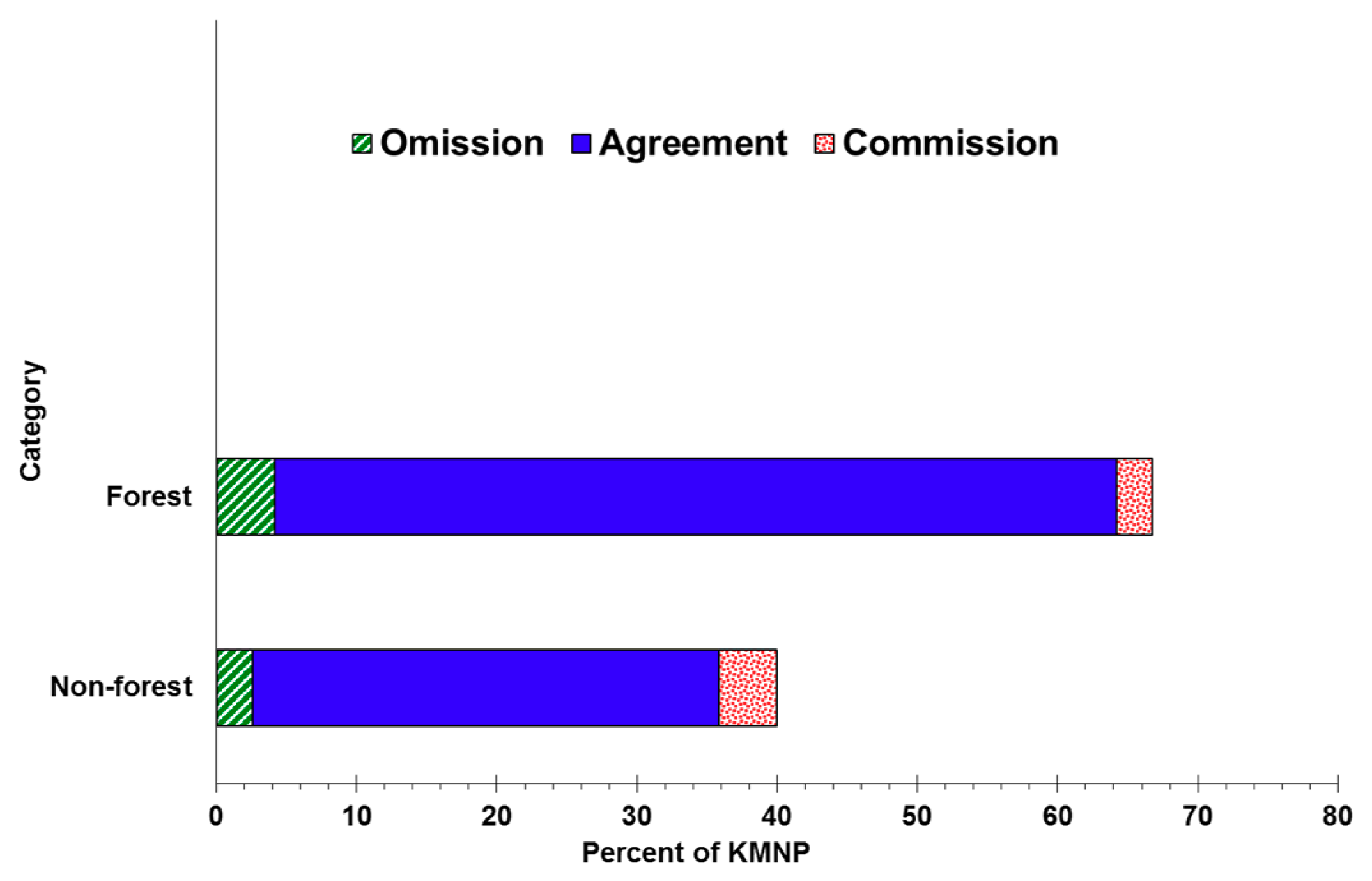
| Stable Components | Change Components | ||||||||||
|---|---|---|---|---|---|---|---|---|---|---|---|
| B | G | W | 4 | 5 | 6 | ΔB | ΔG | ΔW | Δ4 | Δ5 | Δ6 |
| 0.214 | −0.208 | 0.107 | −0.583 | −0.233 | 0.076 | −0.214 | 0.208 | −0.107 | 0.583 | 0.233 | −0.076 |
| 0.197 | −0.172 | 0.140 | 0.060 | 0.039 | −0.638 | −0.197 | 0.172 | −0.140 | −0.060 | −0.039 | 0.638 |
| 0.335 | −0.384 | 0.232 | 0.311 | 0.075 | 0.291 | −0.335 | 0.384 | −0.232 | −0.311 | −0.075 | −0.291 |
| 0.396 | 0.514 | 0.241 | −0.041 | 0.131 | 0.041 | −0.396 | −0.514 | −0.241 | 0.041 | −0.131 | −0.041 |
| 0.359 | 0.050 | −0.503 | 0.142 | −0.308 | −0.018 | −0.359 | −0.050 | 0.503 | −0.142 | 0.308 | 0.018 |
| 0.132 | −0.114 | −0.322 | −0.196 | 0.572 | 0.018 | −0.132 | 0.114 | 0.322 | 0.196 | −0.572 | −0.018 |
| 0.214 | −0.208 | 0.107 | −0.583 | −0.233 | 0.076 | −0.214 | 0.208 | −0.107 | 0.583 | 0.233 | −0.076 |
| 0.197 | −0.172 | 0.140 | 0.060 | 0.039 | −0.638 | −0.197 | 0.172 | −0.140 | −0.060 | −0.039 | 0.638 |
| 0.335 | −0.384 | 0.232 | 0.311 | 0.075 | 0.291 | −0.335 | 0.384 | −0.232 | −0.311 | −0.075 | −0.291 |
| 0.396 | 0.514 | 0.241 | −0.041 | 0.131 | 0.041 | −0.396 | −0.514 | −0.241 | 0.041 | −0.131 | −0.041 |
| 0.359 | 0.050 | −0.503 | 0.142 | −0.308 | −0.018 | −0.359 | −0.050 | 0.503 | −0.142 | 0.308 | 0.018 |
| 0.132 | −0.114 | −0.322 | −0.196 | 0.572 | 0.018 | −0.132 | 0.114 | 0.322 | 0.196 | −0.572 | −0.018 |
| Reference Data | |||||
|---|---|---|---|---|---|
| Classification | Burned | Unburned | Total | User’s Accuracy | |
| Burned | 69 | 9 | 78 | 88% | |
| Unburned | 1 | 165 | 166 | 99% | |
| Total | 70 | 174 | 244 | ||
| Producer’s Accuracy | 99% | 95% | |||
| Reference Data | |||||
|---|---|---|---|---|---|
| Classification | Non-Forest | Forest | Total | User’s Accuracy | |
| Non-forest | 48 | 6 | 54 | 89% | |
| Forest | 4 | 92 | 96 | 96% | |
| Total | 52 | 98 | 150 | ||
| Producer’s Accuracy | 92% | 94% | |||
© 2018 by the author. Licensee MDPI, Basel, Switzerland. This article is an open access article distributed under the terms and conditions of the Creative Commons Attribution (CC BY) license (http://creativecommons.org/licenses/by/4.0/).
Share and Cite
Axel, A.C. Burned Area Mapping of an Escaped Fire into Tropical Dry Forest in Western Madagascar Using Multi-Season Landsat OLI Data. Remote Sens. 2018, 10, 371. https://doi.org/10.3390/rs10030371
Axel AC. Burned Area Mapping of an Escaped Fire into Tropical Dry Forest in Western Madagascar Using Multi-Season Landsat OLI Data. Remote Sensing. 2018; 10(3):371. https://doi.org/10.3390/rs10030371
Chicago/Turabian StyleAxel, Anne C. 2018. "Burned Area Mapping of an Escaped Fire into Tropical Dry Forest in Western Madagascar Using Multi-Season Landsat OLI Data" Remote Sensing 10, no. 3: 371. https://doi.org/10.3390/rs10030371




